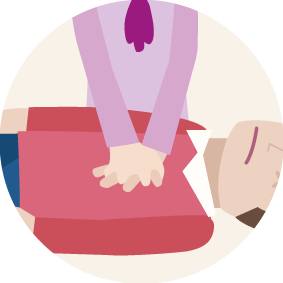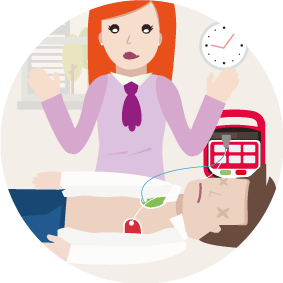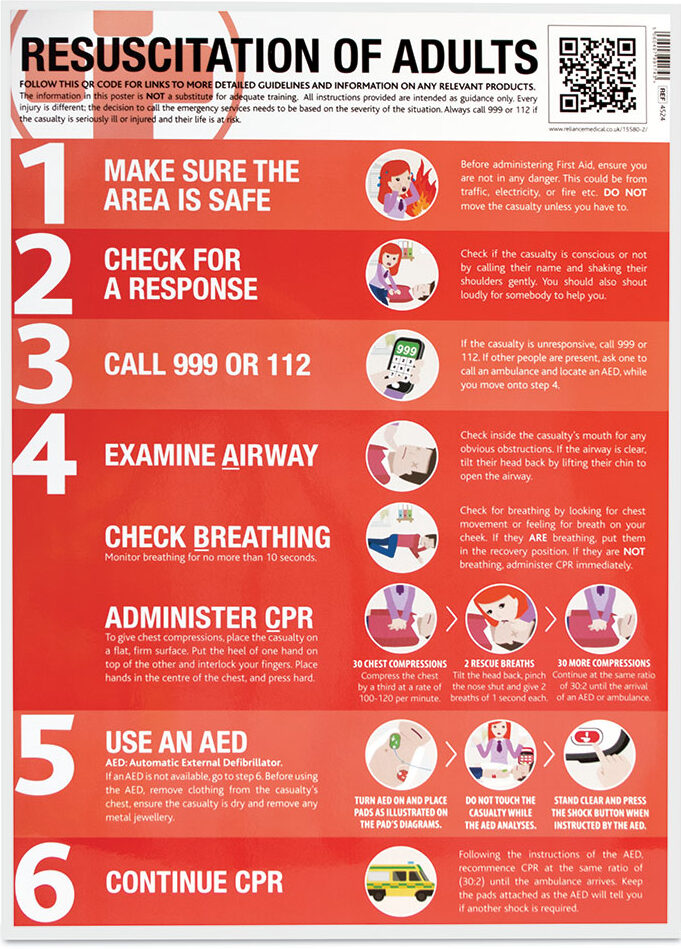Resuscitation of Adults
Additional material to support your information poster, with a quiz to test your knowledge.
CARDIAC ARREST
Cardiac Arrest occurs when the heart suddenly and unexpectedly stops beating normally. When this happens, blood stops flowing to the brain and other vital organs. Ventricular fibrillation, the most common cause of Cardiac Arrest, happens when the electrical activity of the heart becomes so chaotic that it stops pumping and quivers instead. Sudden Cardiac Arrest can happen at any time. Immediate defibrillation and effective CPR can quadruple someone’s chances of survival. Using an Automatic External Defibrillator (AED), is easier than many people think, and they can be used by any bystander without training.

1. MAKE SURE THE AREA IS SAFE
Whenever you approach an incident, your first consideration should be to make sure that the environment is safe. Check for electricity, fire, fumes, traffic etc. Do NOT move the casualty unless you need to.
2. CHECK FOR A RESPONSE
Check if the casualty is conscious or not by calling their name and shaking their shoulders gently. You should also shout loudly for somebody to help you. If someone can help, they should call the Emergency Services and locate an AED while you prioritise checking the casualty’s ABC’s (Airway, Breathing, and Circulation (CPR).
3. CALL 999 OR 112
If someone has responded and has arrived to help, ask them to call and speak to the Emergency Services, otherwise, call them yourself. If possible, stay with the victim while making the call. It is a good idea to activate the telephone’s speaker function; this will aid communication with the Ambulance Service while you begin CPR.
4. EXAMINE AIRWAY
Check inside the casualty’s mouth for any obvious obstructions. If the airway is clear, turn the victim onto their back if they are not already on it. With your fingertips under the point of the victim’s chin, gently tilt the head back and lift the chin to open the airway.
5. CHECK BREATHING
Look, listen, and feel for normal breathing for no more than 10 seconds. In the first few minutes after Cardiac Arrest, a victim may barely be breathing, or just taking infrequent, slow, and noisy gasps. Do not confuse this with normal breathing. If you have any doubt whether breathing is normal, act as though it were not and prepare to start CPR.
6. ADMINISTER CPR
GIVE 30 COMPRESSIONS
Kneel by the side of the victim and place the heel of one hand in the centre of the victim’s chest; (this is the lower half of the victim’s breastbone/sternum). Place the heel of your other hand on top of the first hand, then interlock the fingers of your hands and ensure that pressure is not applied over the victim’s ribs. Keep your arms straight. Do not apply any pressure over the upper abdomen or the bottom end of the bony sternum (breastbone). Position your shoulders vertically above the victim’s chest and press down on the sternum to a depth of 5–6 cm (approximately a third of the depth). After each compression, release all the pressure on the chest without losing contact between your hands and the sternum. Repeat 30 times at a rate of 100–120 compressions per minute.
GIVE 2 RESCUE BREATHS
After 30 compressions, open the airway again by using the head tilt and chin lift manoeuvre (as above), and give 2 rescue breaths. To give rescue breaths, pinch the soft part of the nose to close the nostrils by using the index finger and thumb of your hand that is on their forehead. Allow the mouth to open, but maintain the chin lift. Take a normal breath and place your lips around their mouth, making sure that you have a good seal. Blow steadily into the mouth while watching for the chest to rise, taking about 1 second as in normal breathing; this is an effective rescue breath.
Maintaining head tilt and chin lift, take your mouth away from the victim and watch for the chest to fall as air comes out, then take another normal breath and blow into the victim’s mouth once more to achieve a total of two effective rescue breaths. Do not interrupt compressions by more than 10 seconds to deliver two breaths. Then return your hands without delay to the correct position on the sternum and give a further 30 chest compressions.
GIVE 30 MORE COMPRESSIONS
Continue with chest compressions and rescue breaths at a ratio of 30:2. If you are untrained or unable to do rescue breaths, give chest-compression-only CPR (i.e. continuous compressions at a rate of at least 100–120 per minute).
7. USE AN AED
Switch on the AED and attach the electrode pads to the victim’s bare chest by following the illustrations on the pad’s diagrams. You should ensure that the casualty is dry. Remove any metal jewellery or under-wired bra’s as these can cause burns. If more than one rescuer is present, CPR should be continued while the electrode pads are being attached to the chest. Follow the spoken/visual directions of the AED. Ensure that nobody is touching the victim while the AED is analysing the rhythm.
If a shock is advised, deliver a shock. Ensure that nobody is touching the victim, then push the shock button as directed. Immediately restart CPR at a ratio of 30:2. Continue as directed by the voice/visual prompts.
If no shock is indicated, continue CPR. Immediately resume CPR.
8. CONTINUE CPR
Do not interrupt resuscitation until a health professional arrives and tells you to stop, or you see the victim definitely waking up, moving, opening their eyes, and breathing normally. It is rare for CPR alone to restart the heart. Unless you are certain the person has recovered, continue CPR. If your arms start to tire, see if another person can assist with the chest compressions.
The above information has been based on the guidance of the Resuscitation Council (UK)
Resuscitation of Adults Quiz

All information is for guidance only and correct at time of publication.






